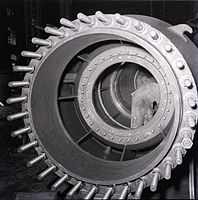
Photo from wikipedia
Abstract In a nickel-producing multiple hearth furnace, there is a problem associated to the automatic operation of the temperature control loops in two of the hearths, since the same flow… Click to show full abstract
Abstract In a nickel-producing multiple hearth furnace, there is a problem associated to the automatic operation of the temperature control loops in two of the hearths, since the same flow of air is split into two branches. A neural model of the post-combustion sub-process is built and served to increase the process efficiency of the industrial furnace. Data was taken for a three-months operating time period to identify the main variables characterizing the process and a model of multilayer perceptron type is built. For the validation of this model, process data from a four-months operating time period in 2018 was used and prediction errors based on a measure of closeness in terms of a mean square error criterion measured through its weights for the temperature of two of the hearths (four and six) versus the air flow to these hearths. Based on a rigorous testing and analysis of the process, the model is capable of predicting the temperature of hearth four and six with errors of 0.6 and 0.3 °C, respectively. In addition, the emissions by high concentration of carbon monoxide in the exhaust gases are reduced, thus contributing to the health of the ecosystem.
Journal Title: International Journal of Chemical Reactor Engineering
Year Published: 2020
Link to full text (if available)
Share on Social Media: Sign Up to like & get
recommendations!